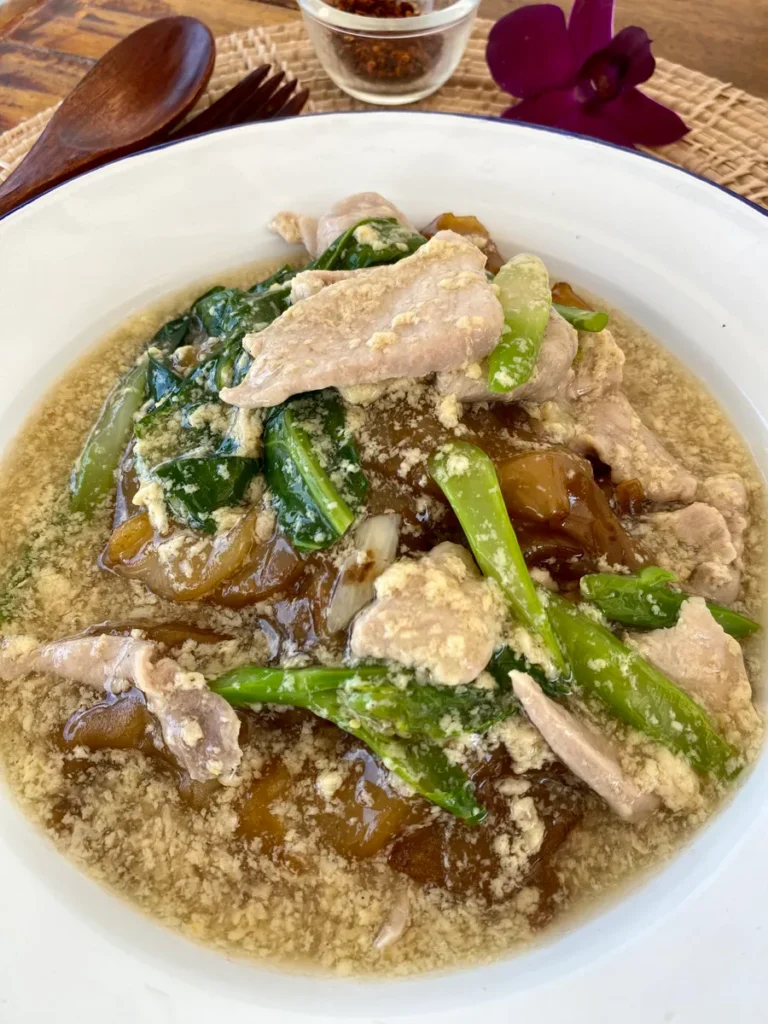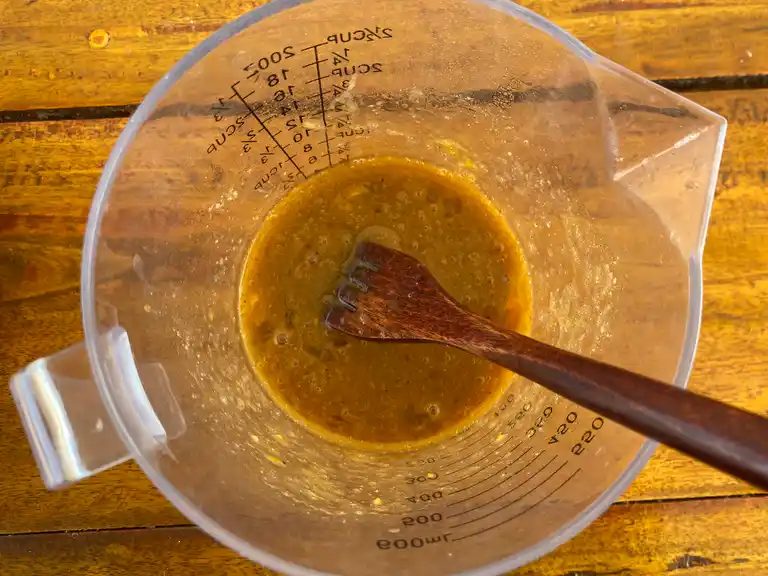This lad na recipe makes Thai noodles with gravy that taste just like the ones in Thailand. You can use chicken, pork, or any protein you like, and the sauce is so good you’ll enjoy every last drop!

Tip: This recipe uses fresh rice noodles. You can make them at home with my gluten free sen yai recipe, or find them at an Asian grocery store. They’re also used to make pad see ew.
Rad na is a Thai noodle dish made with wide rice noodles, meat or seafood, and a thick, savory gravy. It tastes mild, savory, and rich. It’s a popular street food in Thailand, where hot gravy with Chinese broccoli is poured over stir-fried noodles.
About this recipe
Making this recipe starts with marinating the pork, preparing the gravy, and stir-frying the noodles with dark soy sauce. This step not only darkens the noodles but also gives them a slightly sweet, molasses-like flavor.
Rad na sauce is made with soybean paste, soy sauce, eggs, and seasonings. Chinese broccoli gets added to the gravy (the signature vegetable in this dish) before the sauce is poured over the noodles.
You can enjoy it as is, or customize the flavors with your favorite Thai table condiments.

Lad na comes from Chinese cooking, especially the Teochew community that settled in Thailand. Over time, Thai cooks made it their own, blending local flavors with Chinese techniques.
It’s hard to say what recipe is truly authentic because every family makes it a little differently. Some add fish sauce, others add chili flakes, while some don’t like spicy.
This is how I made it at my Thai restaurant, and so many customers loved it!
Ingredient notes and substitutes
Need some guidance? The tips and photos below walk you through each step, or you can scroll straight to the printable recipe card.
For the marinade

- Pork – Pork loin or shoulder works best, but you can also use chicken, beef, seafood, or tofu.
- Oyster sauce – A thick, savory sauce with a hint of sweetness.
- Tapioca starch – Helps lock in moisture and keeps the meat tender while cooking; cornstarch can be used if needed.
- Palm sugar – Adds a caramel-like sweetness that’s deeper than white or brown sugar.
- Egg – Adds richness and helps tenderize the meat.
For the noodles and gravy

- Fresh flat rice noodles – Use soaked dry noodles or vermicelli if fresh ones aren’t available.
- Dark soy sauce
- Chinese broccoli – Known as gai lan, this leafy green has thick stems that should be peeled before cooking.
- Soybean paste – A fermented paste that adds umami and depth to the gravy; optional but highly recommended. Get it on Amazon.
- Light soy sauce
- Rosdee seasoning powder – RosDee is a Thai seasoning powder that adds umami and depth. You can find chicken, pork, or beef flavors—use the one that matches your dish or taste! Order it here.
- Tapioca starch – Used to thicken the gravy; adjust depending on how thick you like your sauce.
- Eggs – Add creaminess and richness to the gravy; optional but standard in my family’s recipe.
- Water
- White pepper
- Garlic
How to make lad na
Marinate the pork
Step 1: In a large bowl, crack in the egg and mix with palm sugar, oyster sauce, tapioca starch, and sliced pork. Stir everything well to coat the meat evenly, then cover and refrigerate for at least 2 hours or overnight for the best flavor.

Mix the gravy base
Step 2: In a separate bowl, combine soybean paste, white pepper, light soy sauce, and rosdee seasoning powder. Whisk until well mixed.

Step 3: In a small cup or bowl, mix tapioca starch with 100 ml (just under 1/2 cup) of water until smooth. This will thicken the gravy later.

Stir-fry the noodles
Step 4: Place the fresh rice noodles in a bowl and mix them with dark soy sauce using your hand (wear gloves if you like). If using dry noodles, soak them first as per the package instructions. Stir-fry the noodles in a hot wok for 1–2 minutes just to warm them through and get a bit of char. Set the noodles aside.

Cook the gravy
Step 5: In the same wok, add oil over medium heat and sauté the garlic until golden and fragrant. Be careful not to burn it.
Step 6: Add water to the wok and bring it to a boil. Once boiling, add the marinated pork and spread it out, so the slices cook evenly without sticking together.

Step 7: Pour in the gravy mixture from Step 3. Stir gently to mix. Don’t worry if the egg floats to the top and sets in soft clumps; that’s exactly what you want. It gives the sauce a silky, rich texture.

Step 8: Add the sliced Chinese broccoli stems and leaves to the gravy. Let everything boil together for about 2 minutes, or until the vegetables are tender but still bright.

Step 9: Give the tapioca starch slurry a quick stir, then pour it into the boiling gravy while stirring. Keep stirring for a minute or so until the sauce thickens to a silky, glossy consistency.

Step 10: Once the gravy has thickened and everything is cooked through, turn off the heat. The sauce should coat the back of a spoon and cling to the meat and veggies.

Top the noodles with gravy
Step 11: To serve, place the stir-fried noodles on a plate or in a bowl and pour the hot lad na gravy over the top. Make sure there’s a good mix of meat and vegetables in each serving. Serve immediately and enjoy while warm. Garnish with green onions, chili flakes, fried garlic, and prik nam som.
How to store and reheat
- Storage: Store any leftovers in an airtight container in the fridge for up to 3 days. Keep the noodles and gravy separate if possible, so the texture stays better when reheated.
- Reheat: To reheat, warm the gravy in a saucepan over low heat, adding a splash of water if it’s too thick. Microwave the noodles or quickly stir-fry them in a hot pan, then pour the hot gravy over just before serving.
More Thai noodle dishes to try
This lad na recipe makes a great Thai dinner for any day of the week! If you gave it a try, leave a comment and a star rating. Follow me on social media: Facebook, Instagram, and Pinterest.
Lad Na Recipe (Thai Noodles with Gravy)

Equipment
- cutting board and knife
- Mixing bowls (To marinate the meat and prepare the gravy and slurry.)
- Wok or large skillet
- spatula
Ingredients
For the marinade
- 300 g pork, thinly sliced
- 1 large egg
- 8 g palm sugar
- 15 ml oyster sauce
- 8 g tapioca starch
For the noodles and gravy
- 600 g fresh wide rice noodles, if using dry rice noodles, use a little less than half the suggested weight
- 5 ml dark soy sauce
- 15 ml oil
- 3 cloves garlic, minced
- 1 l water, for the gravy
- 200 g Chinese broccoli, stems peeled, leaves chopped
- 15 ml soybean paste
- 22 ml light soy sauce
- 12 g rosdee seasoning powder
- 2 g white pepper
- 25 g tapioca starch
- 100 ml water, for mixing with tapioca starch
Instructions
Marinate
- Crack the egg into a large bowl and combine it with palm sugar, oyster sauce, tapioca starch, and the sliced pork meat. Mix thoroughly, then let it rest in your fridge for at least 2 hours or overnight.1 large egg, 8 g palm sugar, 15 ml oyster sauce, 8 g tapioca starch, 300 g pork
Prep the gravy
- In a large mixing bowl, combine soybean paste, white pepper, light soy sauce, and rosdee seasoning powder. Combine until well blended.15 ml soybean paste, 22 ml light soy sauce, 12 g rosdee seasoning powder, 2 g white pepper
- In a separate cup, thoroughly mix tapioca starch and just under 1 cup (100 ml) of water.25 g tapioca starch, 100 ml water
Stir-fry the noodles
- In a large bowl, combine the fresh rice noodles with black soy sauce. If you’re using dry noodles, first soak them in water according to package labeling. Use your hand and a plastic glove to mix. Next, stir-fry the noodles for just 2 minutes and set aside.600 g fresh wide rice noodles, 5 ml dark soy sauce
Cook the gravy
- In the same pan over medium heat, add oil and garlic, fry until it turns golden and fragrant.15 ml oil, 3 cloves garlic
- Add water and bring to a boil. When boiling, add pork and spread out the meat to ensure it doesn’t stick to each other.1 l water
- Add the mix of gravy prepared earlier once the water comes to a boil. Stir gently just to mix.
- Add Chinese broccoli and let boil for 2 more minutes, or until soft enough.200 g Chinese broccoli
- Give your tapioca starch and water mixture another stir. Make sure your gravy is boiling and pour it in as you stir the gravy. Keep stirring afterward to make sure it gets well mixed with the gravy (important!!).
- When the lad na sauce thickens, your gravy is ready.
- To serve, place the stir-fried noodles in a bowl or on a large plate and pour the gravy over them.
Notes
- Use the nutrition card in this recipe as a guideline.
- Use fresh flat rice noodles for an authentic taste and texture. If you can't find these, you can use rice vermicelli or dry noodles.
- Pork is the most common choice of meat, but you can also use beef, tofu, chicken, or seafood.
- Adjust the amount of tapioca starch to achieve your desired thickness of the gravy.







Very good recipe. The rad na I used to eat in Bangkok had a lot more sweet soy sauce in the gravy, but other than that, spot on! My wife and son loved it! Thank you very much!
Hey Mike,
I’m glad you and your family enjoyed the recipe! Thank you for leaving a comment.